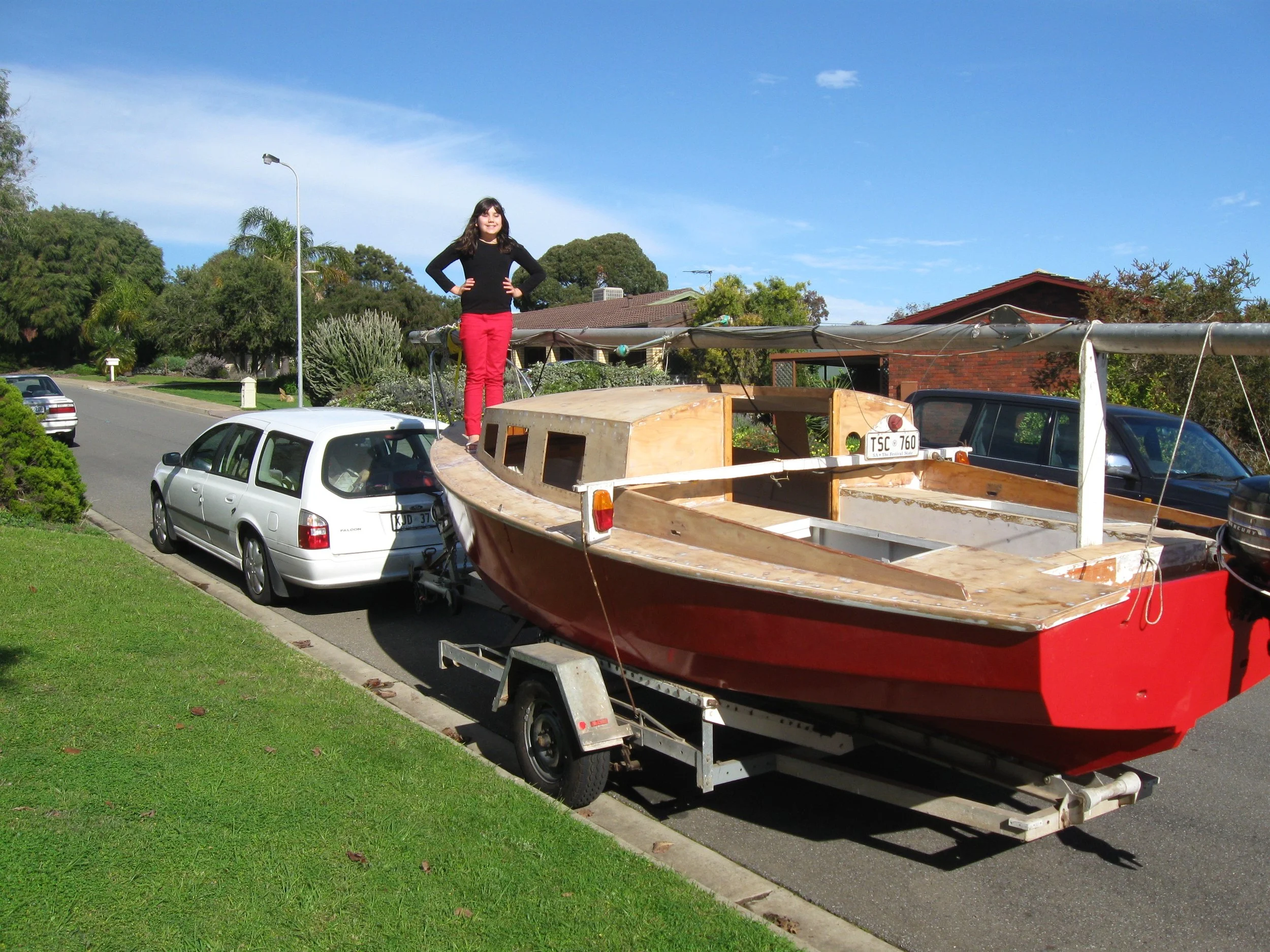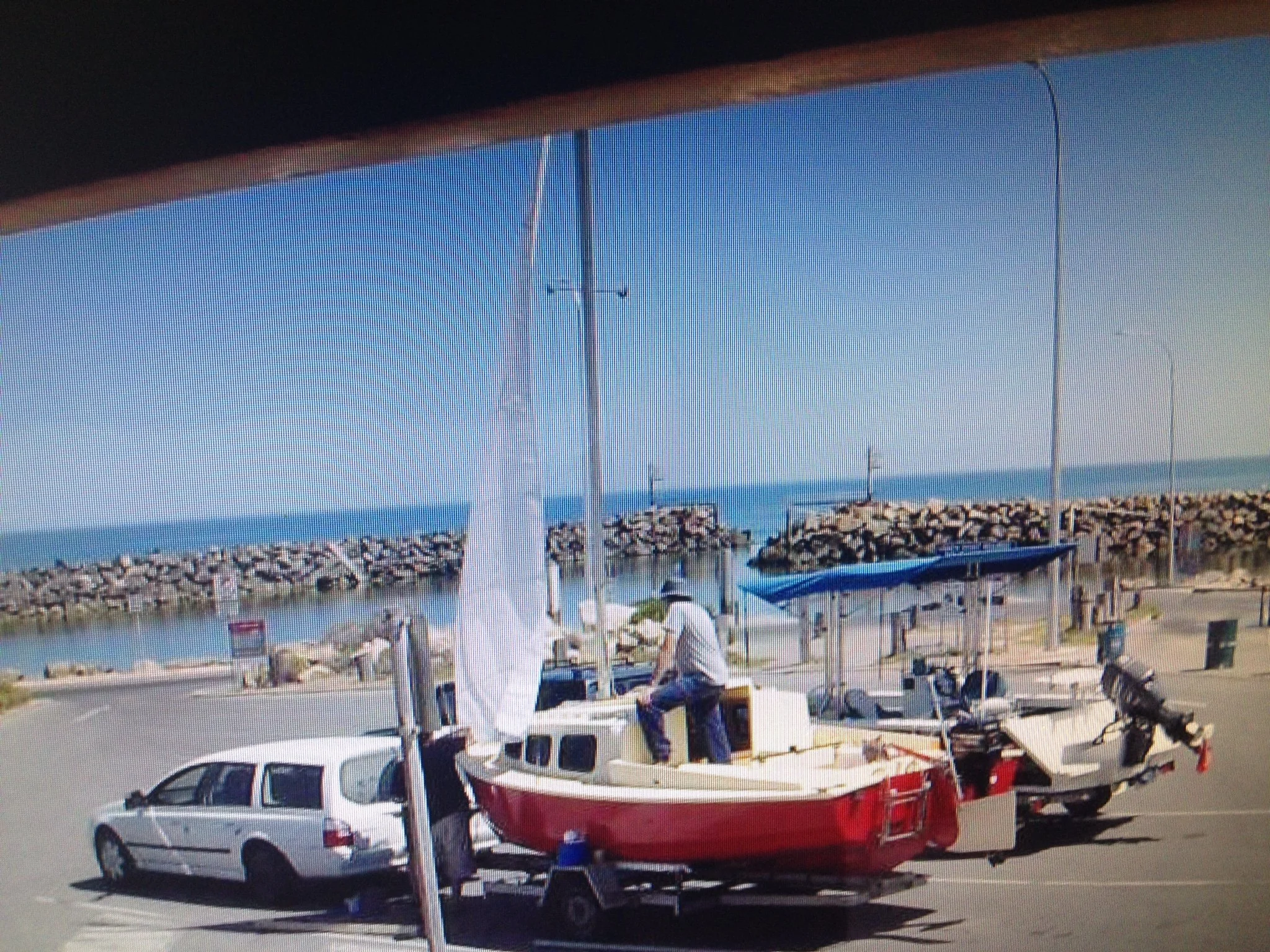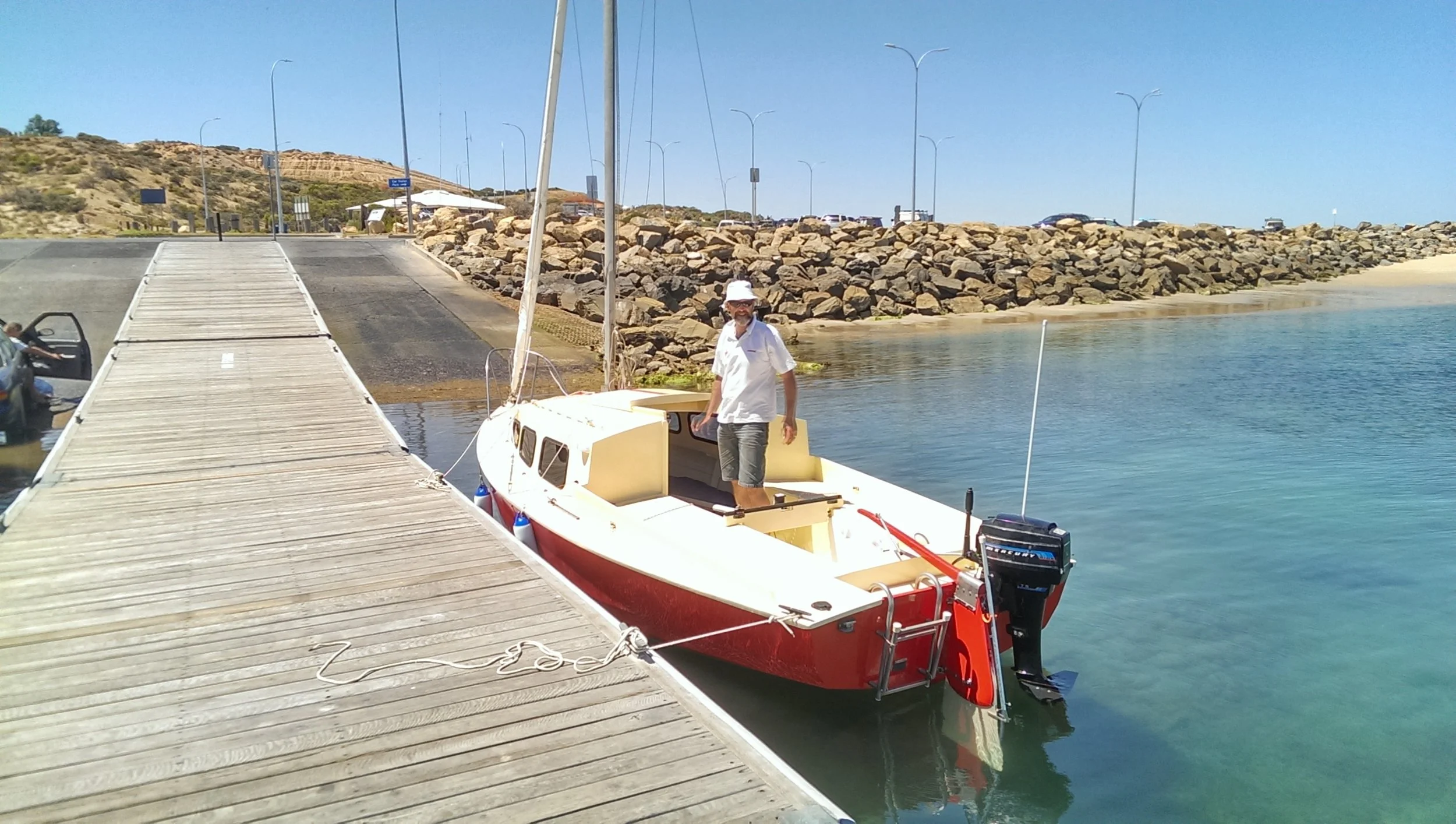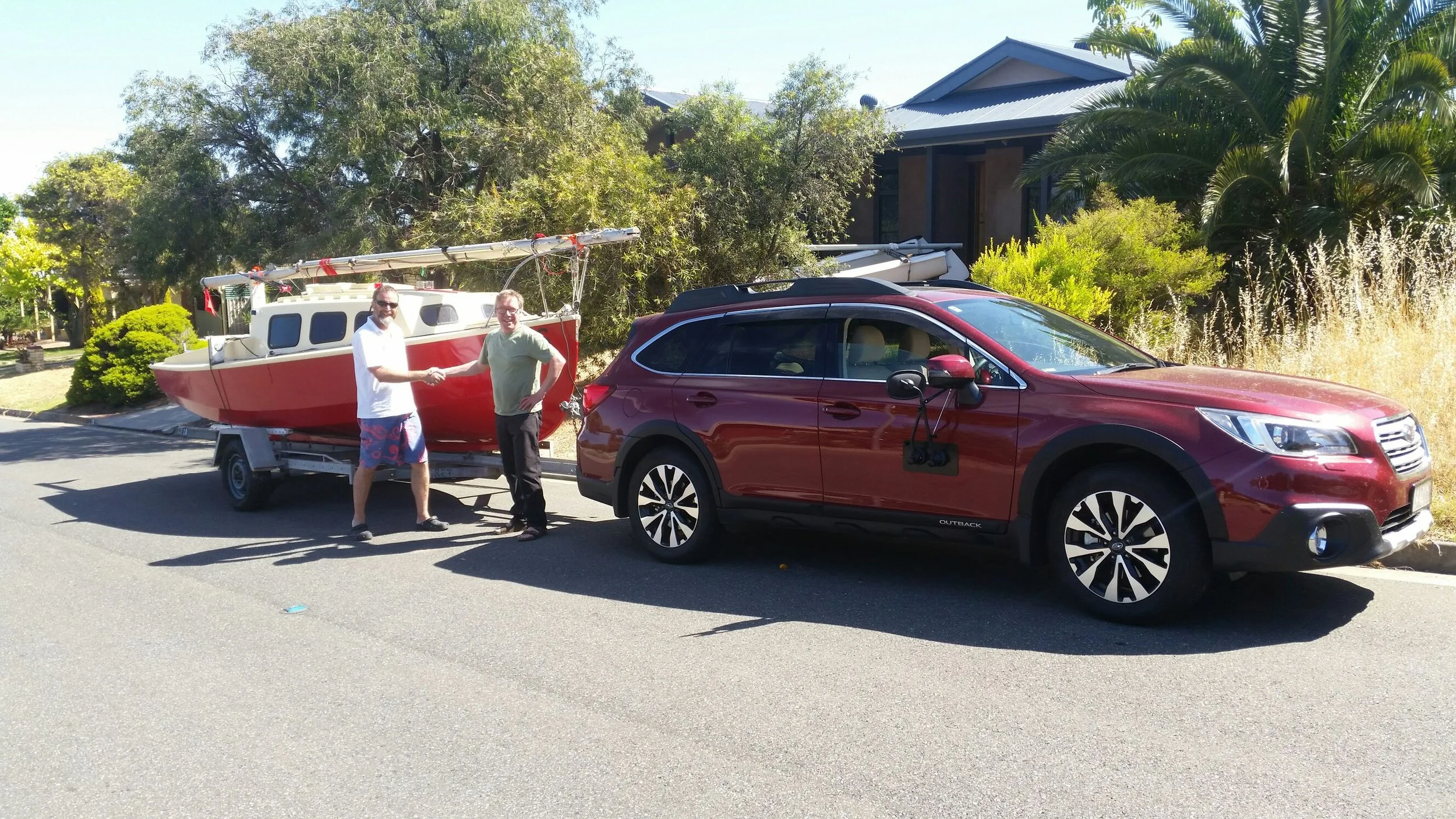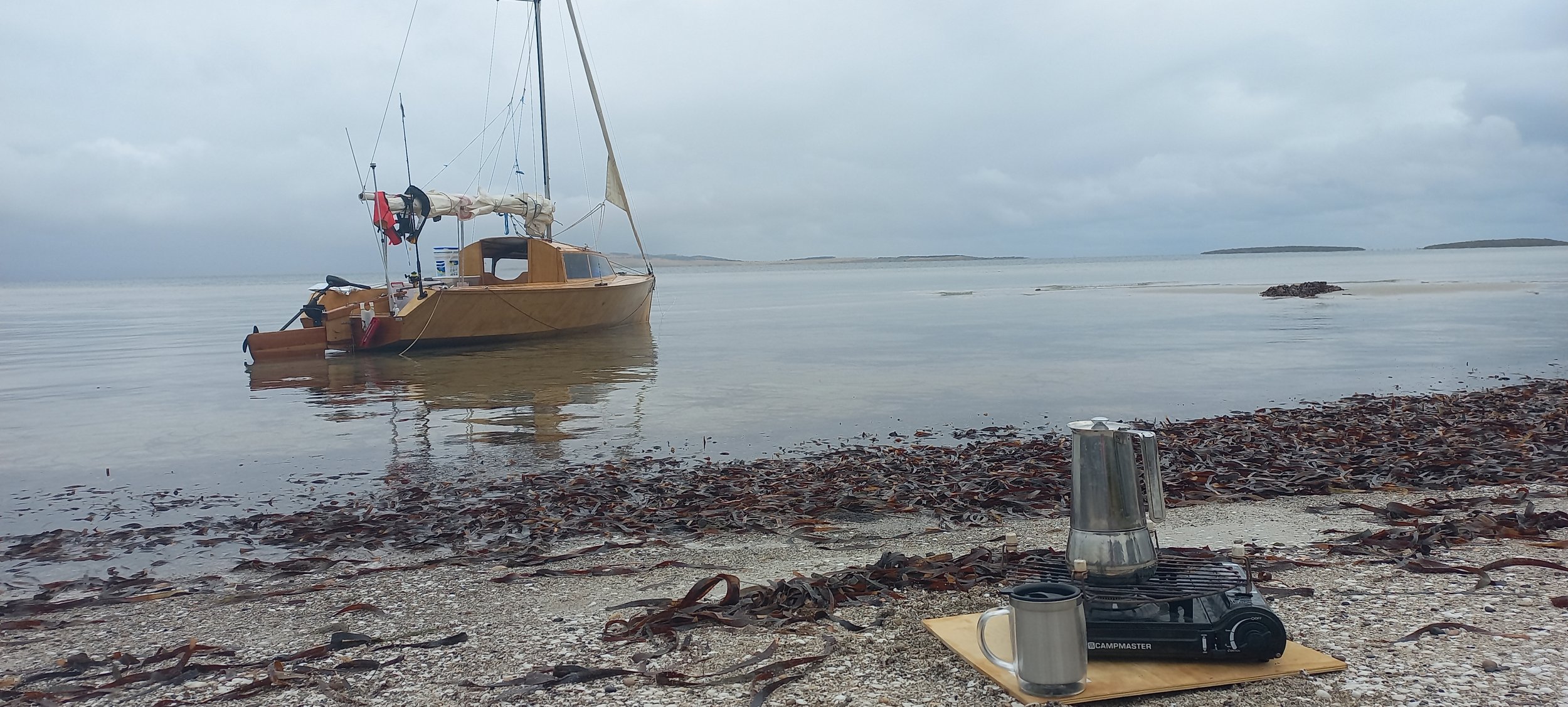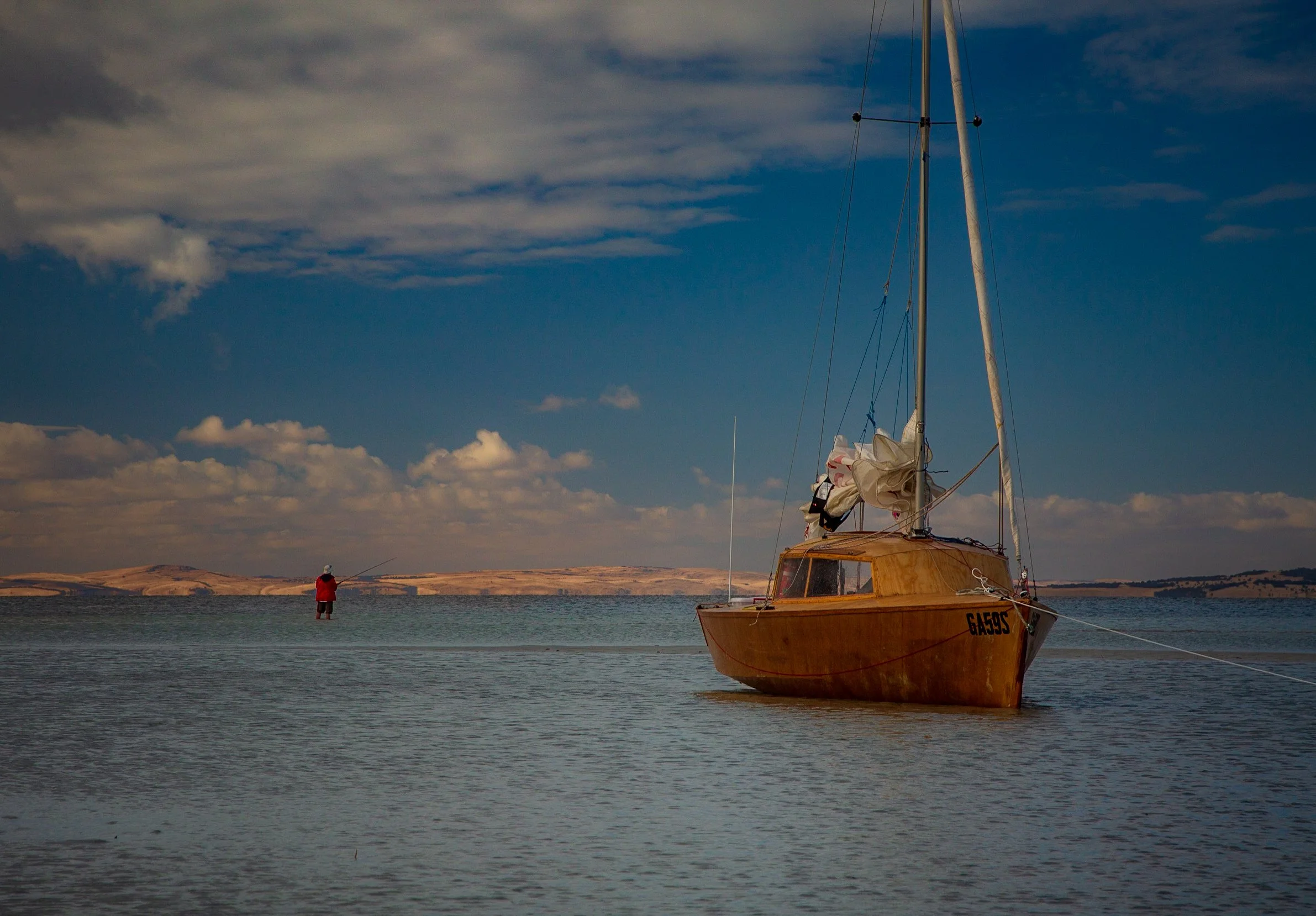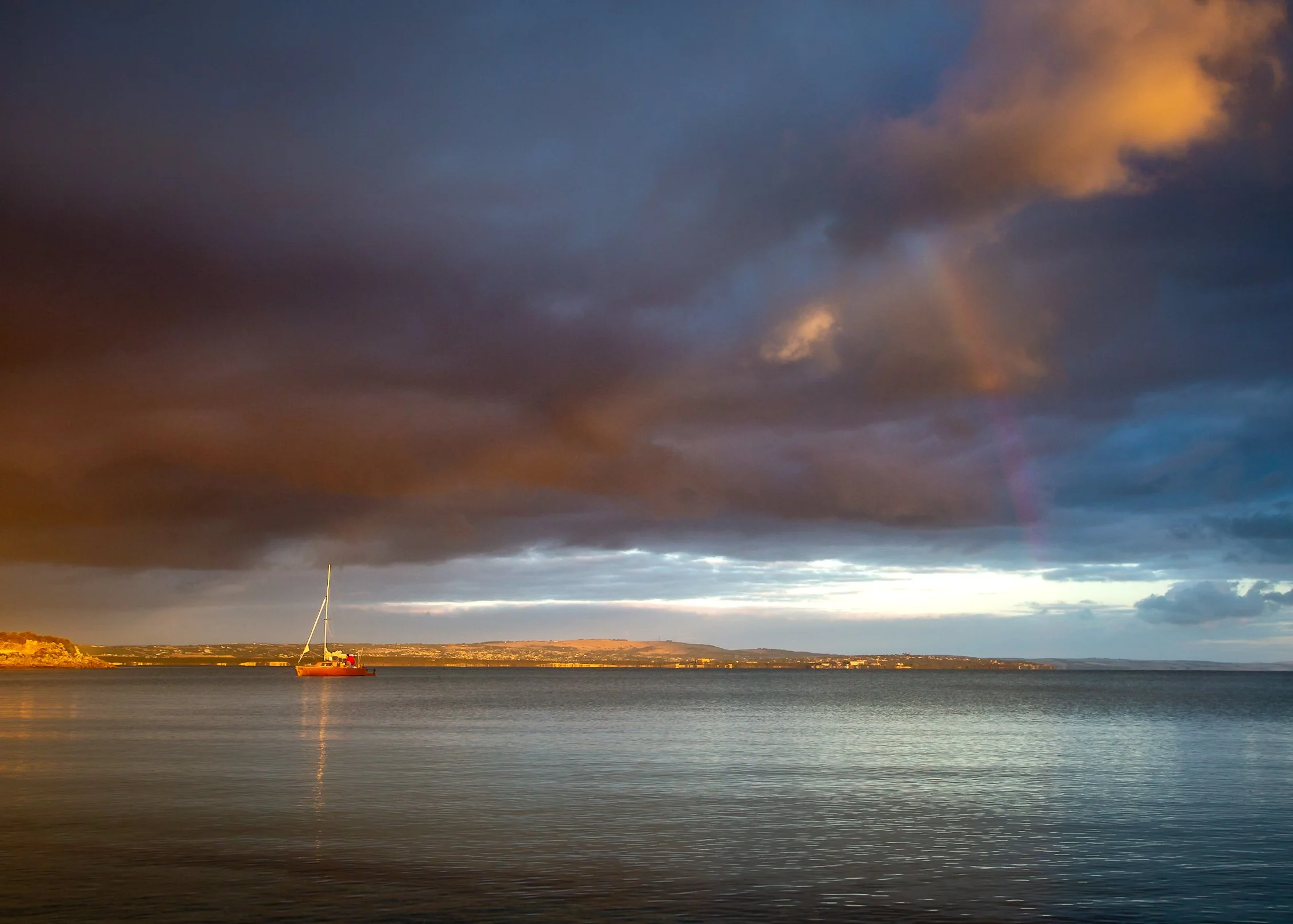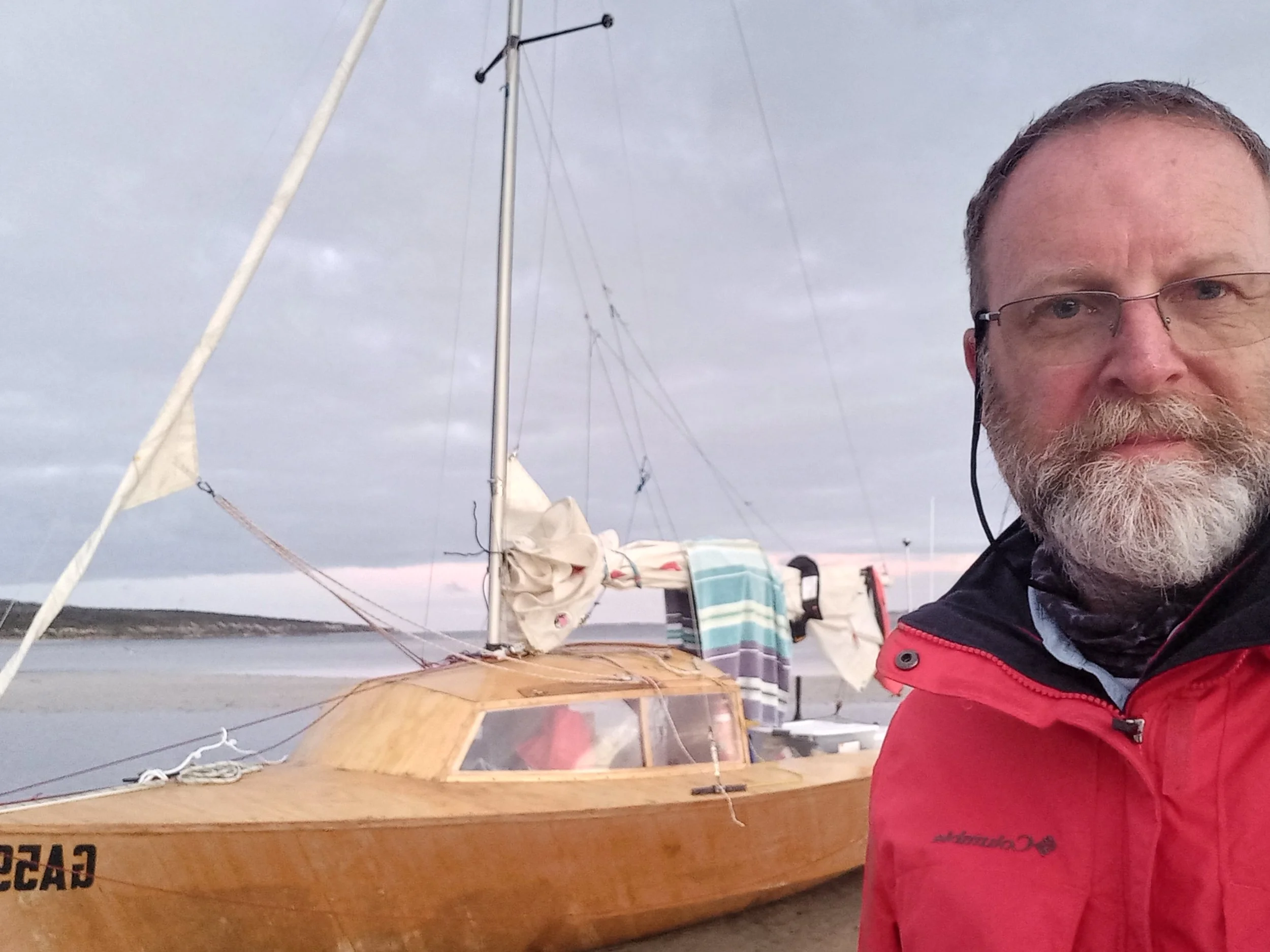Procrastination, compromise & Hofstadter’s Law
By David Hains
Photo: Paul Deeble
Part One
A return to sailing after a long time
out of the water.
My dreams of boat building go back a very long way, to 1979 in fact. I was 10 years old, my dad went to PNG for work and returned with a copy of the Air Niugini in-flight magazine which had an article on racing proas. I was captivated by these amazing crafts, even without ever being sailing before, and after this I remember spending a lot of time sketching sailing boats. Skip forward 10 years and I am racing dinghies out of Port Lincoln Yacht Club. Another 20 years after this I am now living in the city, married with three kids, I have no boat and no time, but I do have a heap of windsurfing gear collecting dust in the shed. I find myself spending a heck of a lot of time on the internet looking at pictures and plans of boats.
Without prompting, my 6-year old son asks if we could build a boat together. I mention this to Peter, a colleague at work who then tells me about the boat that his dad built with him, and the other boat that he built with his son. Hmmm … my wife does keep telling me I need a hobby. But of all the pictures, designs, websites and books that I have seen, what do I want to build? Wet boats or dry boats, monos or multis, build or restore? While my wife was encouraging me (only if I sold my windsurfing gear and cleaned out the shed), she had never sailed before and only really took a passing interest. That is, until she looked over my shoulder one night while I was on Gumtree.
The original Gumtree advertisment
“That one.” She had no idea what that one was except it was red, kind of classy-looking, half restored, possibly a dry ride, in my price range, and only 20 minutes away. “Should we go down tomorrow and have a look together?” I asked. “No, just buy that one,” she replied. I never thought it would be so easy. A couple of days later and I have a half-restored Hartley 18 sitting in my carport.
The boat arrives at home, and the kids come out for an inspection
The guy that had it before me was a retired woodwork teacher and keen sailor. He’d done all of the hard work (or so I thought), but then had a heart attack and the boat was never finished. The hull was complete on the outside, finished in a nice “Fire Truck Red”, there was a crispy new set of sails, and everything I needed to finish her off except for the sandpaper, elbow grease, and paint.
Skip forward another year. My now-former work colleague Peter tells me about 'Hofstadter's Law', conceived by the cognitive scientist Douglas Hofstadter, which states: any task you're planning to complete will always take longer than expected - even when Hofstadter's law is taken into account. He should have told me about that earlier.
Hofstadter’s Law strikes again!
We eventually made it to launch day, a very private affair because I couldn’t stand the idea of people watching in case I dropped the mast on someone’s head. My son loved his first trip, especially having a pod of twenty dolphins circle us. I was looking forward to many more trips together, perhaps a drive to Lincoln to check out my old sailing grounds, and maybe even an overnighter or two.
I parked in front of the webcam at the boat ramp so that my family could watch from home without the risk of dropping the mast on their head (this was a photograph of the webcam view on our home computer)
It floats!
Intermission
After sailing my Hartley for a year, and having a great time, I was starting to wonder if it was the right decision for a number of reasons: it was hard to find a crew who had the same days off as me, the family weren’t over-enthusiastic about coming out, and I was not happy about having a lot of money sitting on a trailer in the front yard doing nothing for most of the time. It had been a great project, and it was a great boat, but I started to wonder if any of it was right for me. It sold quickly, I didn’t lose any of my money, and soon it was heading across the border to Victoria.
A year later and I find myself looking at “boat porn” again.
Part 2
– bundin er bátleysur maður
Bound is a boatless man (Viking Proverb)
For the next year I was a bit aimless and couldn’t help thinking about how I missed sailing. As a mental health professional I know the importance of having activity, hobbies, time outside, exercise, and human connection. I also know how good I feel after a day on the water, I would usually come home exhausted but with a complete sense of just feeling good.
My new boat had been sailing in Goolwa for a couple of years but the owner wanted to upgrade. The uniqueness of it caught my eye, and it turned out that it actually was a one of a kind. I bought it for well under half of what I sold the Hartley for, and it was all ready to sail.
I don’t know much about it, but it was built by someone with the initials of R.B.W. and launched in 1999. My understanding is that it came from an amateur designer/builder in N.S.W. and that this was his last boat, a retirement present to himself. It was built from Hoop Pine marine ply, with 2 layers of 200x3mm strips cold moulded over a simple and lightweight frame. There is a swing-keel with a reasonable amount of lead in it. The cabin is basic but just enough room for 2 people to sleep or shelter from the weather. The boat is pretty light, easy to tow (under 650kg including trailer), and easy to launch and retrieve. It came with an electric outboard, big enough to get on and off the dock, but not big enough to punch into a strong head wind.
For the rig, the designer has used parts from off the beach dinghies. The mast and mainsail are from an Australian Sharpie, and the current jib is from a 14-foot skiff. While the sail area is smaller than the Hartley, the overall weight of the rig is much lighter so I can now pick up the mast and can rig the boat single handed. Replacement parts are cheap too – when I needed a new mainsail I just made a few phone calls and found a main + jib in really good condition in the shed of an ex-racer who had probably only used it for a couple of seasons. The best $100 that I have ever spent. A quick trip to a local sail loft and for a few more dollars I had 2 reefing points.
After the purchase I have only ever modified a few things; replaced the battery and moved it forward of the centre case, installed a VHF radio and a couple of lights, installed a bilge pump, and tinkered with some of the rigging. Last year I took the deck and cockpit back to bare wood and covered it with 8 coats of varnish. This year I will do the same to the hull.
I have started using it a bit more in the last year and have become familiar enough to be able to rig, launch, sail, retrieve and unrig single handed. It’s not that I want to sail single handed, but there are some days when the weather is perfect, I have the day off, but everyone else is working.
The Sharpie mast has fittings for a spinnaker and trapeze wires, so I am thinking that a trapeze might be good both for performance in moderate-strong winds and for a bit of fun (come on kids).
Part 3
The climax
After a winter I would prefer to forget, I knew it was time for a holiday. As an introvert (married to an extrovert) I am quite happy to have restrictions on interstate and international travel (sorry Athena). I took this as an opportunity to return to my old sailing grounds out of Port Lincoln.
Road Trip
Boston Bay is perhaps the finest sailing harbour in Australia. It is almost four times the size of Sydney Harbour, with protected anchorages in every direction. Port Lincoln is 650km away from Adelaide. The town sits on the western side of Boston Bay. On the eastern side of the bay is Boston Island, a 2400 acre privately owned sheep station, which is the perfect size to protect the bay from any weather coming from the east. There are plenty of places to visit outside of the bay and within an easy day’s sail for those who want to explore further (e.g. The Joseph Banks Group of islands, and the South-Eastern parts of the Eyre Peninsular including Memory Cove and the islands named in honour of Matthew Flinders’ lost crew). But for me my plan was to remain inside the bay and explore some of the numerous beaches and anchorages in the Port Lincoln National Park on the Eastern side of Boston Bay, all within a couple of hours sailing from the town’s boat ramps.
Accompanying me for the trip was Paul, a fellow nurse, outdoor enthusiast, amateur photographer, rookie sailor, and an easy guy to get along with for a week. We launched from Billy Light’s Point, a modern 3 lane boat ramp protected from weather coming from any direction. The wind was blowing 10-15knots from the south, and we headed off with 1 reef in the mainsail. The first leg was a 2-hour tight reach to our first camping spot at Woodcutters Beach. (The 2 hours included a sailing lesson for Paul which consisted of showing him the safety gear, introducing him to the jib sheet, and telling him where to put his inbuilt ballast.) It was great to be on my home ground again but this time it was a slow trip across the bay compared with the old days of dinghy sailing
The launch pad
Now that I have hit 50 I really don’t mind life in the slow lane, in fact I really enjoy it. For me 2 hours on the water is 2 hours on the water. It doesn’t matter if I travel 2 miles or 20, it’s still 2 hours. However, I find that 2 hours without rushing is actually more enjoyable – I get to relax, have a conversation and enjoy the scenery rather than having to focus on the boat, weather, crew and boat speed. In fact on the return trip the wind was under 10knots and I put a second reef in the main so that I could relax and enjoy the trip even more.
For the next 5 days we moved around the National Park, choosing our anchorage depending on which way the wind was blowing, and we had plenty of options to hide from the southerly winds. Not that we needed to worry too much, with the centreplate up the boat needs only a foot of water to float so we could park pretty close to the shore. It didn’t matter if the tide went out as the bottom of the hull is relatively flat and the boat can sit upright on the sand at low tide.
Grounded
We travelled from Woodcutters to Monument Beach, then Fisherman’s Point. From there we could walk north to Cape Donington (one of two entrances to Boston Bay) or across to the eastern side of the peninsular (Carcase Rock or Yachties Beach) and explore some of the great beaches and anchorages to park when the wind comes from the west.
Photo: Paul Deeble
Living on a small boat for a week is pretty easy, but only if your crew brings a tent. Paul was happy to sleep on dry land, which gave me more room to stretch out in the small cabin. A simple boom tent would be next on my shopping list to create a bit of shade and make the cockpit a little more useable in both sun and rain. Cooking was easy with a simple single burner butane stove supplying enough food, tea and coffee for the week, however Paul prefers a metho-fired Trangia for camping and hiking as they are small, light and simple. For him that was probably a good choice, considering how much photography gear he wanted to carry. As you can see, his camera was put to good use.
Coffee time
One of the great things about sailing in Boston Bay is that it’s safe. There is a large amount of boat traffic in the area (fishing, working and recreational) should you ever get into trouble. You can get mobile phone reception in most of the bay and National Park. The road from Port Lincoln to Cape Donington is sealed most of the way and only a 1-hour drive. It was reassuring to have my brother in town who could rescue us in either his car or runabout should we need it, but in reality it would be unlikely that we would need him. We did however enjoy his company at Monument Beach when he and his wife brought us a picnic lunch.
Photo: Paul Deeble
While we were away I received an interesting phone call from my wife in Adelaide to tell me that the Port Lincoln police had called her after noticing my car and small boat trailer at the boat ramp for a few days. An off-duty police officer was concerned that our little boat hadn’t returned after some bad weather so he contacted the station who tracked down Athena through our car registration. Athena was happy to tell them that I had been checking in with her and my Port Lincoln family every day and that all was well. While we were safe and oblivious to any concerns, it was great to know that the local constabulary were going above and beyond the call of duty by keeping an eye out for boaties who fail to return.
The last thing we had to do was find the boat ramp again, a simple trip in under 10 knots and the best weather for the week.
Postscript & reflections
An 18-foot timber trailer sailer combines the romance of a timber boat with the benefits of a small trailable package. My boat turns a lot of heads both on the road and the at the boat ramp. She is a very simple craft to use and maintain, and it’s not too expensive either. She sure is a hell of a lot nicer than a modern plastic thing, even if she is not the fastest or most hi-tech. There is a lot to be said for trailable sailing; I can drive anywhere in South Australia in under a day, and there are plenty of options for safe boating in beautiful places.
I agree with the saying that there is a direct relationship between the size of a boat and the amount that it gets used, well at least it fits for me. I can keep the boat on a trailer in the front yard, it’s a 10-minute drive to the boat ramp, and about 40 minutes to have her rigged and then backing down the ramp. A larger boat (or even the Hartley which was the same length) takes longer (and more money) to do everything from rig, launch, and maintain.
Wooden boats do not have to be limited to the pages of a glossy calendar, an online magazine, or an occasional dream after a visit to a wooden boat festival. Go small, keep it real (and affordable), and get out on the water in something that’s classic, not plastic.
Photo: Paul Deeble
The author
David Hains is a Mental Health Nurse/Counsellor in Adelaide who runs his own business Left Turn www.leftturnsolutions.com.au
David is keen to hear from anyone who knows more about the boat designer, build, or history – david@leftturnsolutions.com.au



